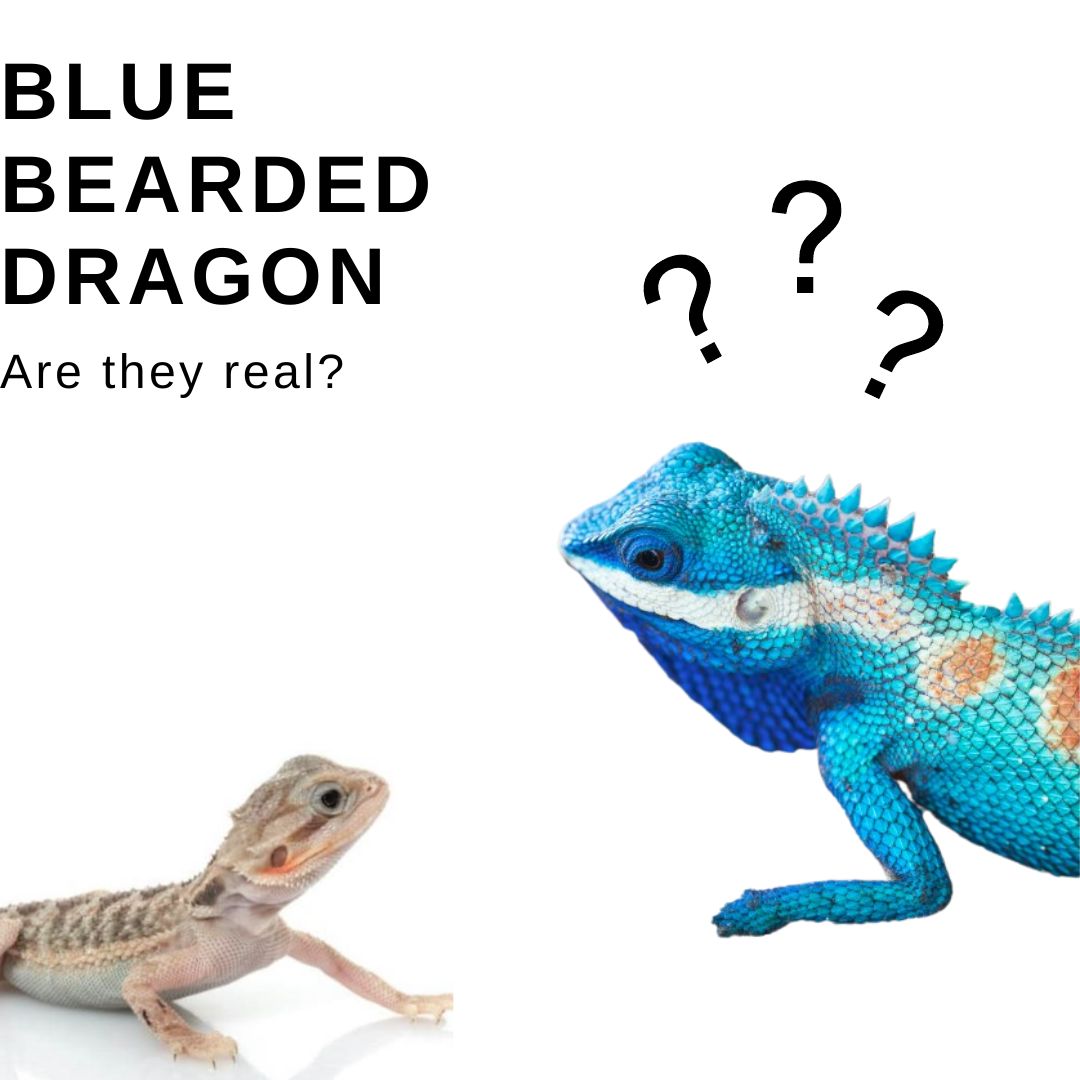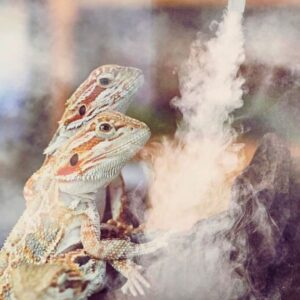The blue bearded dragon is a fascinating reptile that has become increasingly popular among reptile enthusiasts.
With its stunning colors and unique appearance, this species is sure to capture your attention.
In this comprehensive guide, we will dive deep into the world of blue bearded dragons, exploring their origin, physical characteristics, care requirements, behavior and temperament, breeding, and legal considerations.
Whether you are a current blue bearded dragon owner or simply intrigued by these captivating creatures, this article will provide you with all the information you need to know.
Blue Bearded Dragon: Table of Contents
Are blue bearded dragons real?
While you can find some with hints of blue in the bars on their backs, completely blue bearded dragons are not real and are often the result of edited photos.
Blue-bar bearded dragons, also known as “hypo-trans,” are a specific morph characterized by two traits:
- hypomelanotic (lacking melanin) and
- translucent (almost see-through).
Breeding dragons with these traits can produce blue-barred offspring, even if the parents don’t exhibit the blue color themselves.
Blue-barred dragons are rare in chain pet stores but can be readily found through reputable breeders. However, the blue color may not always be visible due to shedding, stress, age, or the dragon not actually having the required genes.
Bearded dragons come in normal scale, leatherback, and silk-back. All of these morphs can be bred to be hypo-trans with blue bars.
Regardless of their base color, all bearded dragons can technically carry the genes for blue bars, but it may not be visible in darker dragons.
The lack of melanin is crucial for the blue color to show, so black and darker beige dragons may not display blue bars.
Origin and Natural Habitat
Blue bearded dragons are native to a specific region in Australia. They are primarily found in the arid and semi-arid regions of eastern and southeastern Australia. These habitats consist of dry, rocky outcrops and open woodlands, providing the perfect environment for these reptiles to thrive.
Blue coloration in bearded dragons is a result of selective breeding (morphs). While there are some naturally occurring blue specimens, the majority of blue bearded dragons available in the pet trade are bred for their unique coloration.
Physical Characteristics and Appearance
The blue bearded dragon, as the name suggests, gets its name from the blue hues present on its body.
These dragons have a blue-gray base color with varying degrees of intensity and patterns. Some individuals exhibit a solid blue coloration, while others may have intricate patterns and markings that add to their beauty.
In addition to their stunning blue color, blue bearded dragons possess the same physical characteristics as their counterparts. They have a stocky build, a spiky beard that can be expanded when threatened or displaying dominance, and a row of spines running down their backs.
Blue bearded dragon size
The size of blue bearded dragons can vary, but on average, they reach a length of around 18-24 inches when fully grown. Their tails make up a significant portion of their length and are often used for balance and communication.
Lifespan and Growth
Blue bearded dragons can live up to 10-15 years when properly cared for. However, diet, habitat conditions, and overall health and care can influence their lifespan.
Blue bearded dragons undergo a noticeable growth phase during their first year of life. As hatchlings, they are about 3-4 inches in length and grow rapidly during the first few months. By the end of their first year, they usually reach a substantial size but continue to grow at a slower rate throughout their lifespan.
Caring for a Blue Bearded Dragon
Ideal Environment and Habitat Setup
The enclosure should be spacious enough to allow the dragon to move around freely. It should contain appropriate substrates, such as reptile carpet or sand, to provide a comfortable surface for walking and basking.
Lighting and heating are crucial for the health of blue bearded dragons. They require access to a UVB light source to ensure they receive adequate levels of vitamin D3, which aids in calcium absorption.
A basking spot with a temperature range of 95-105°F should be provided to allow the dragon to regulate its body temperature.
Dietary Requirements
Blue bearded dragons are omnivorous, meaning their diet consists of both plant matter and animal protein.
The primary component of their diet should consist of a variety of leafy greens and vegetables. Examples include collard greens, kale, dandelion greens, and butternut squash. It is important to provide a diverse selection of greens to ensure they receive a wide range of essential nutrients.
Protein should be offered in the form of insects and occasionally small vertebrates, such as pinky mice. Popular insect options include crickets, mealworms, and dubia roaches. It is important to gut-load and dust these insects with calcium and vitamin supplements to prevent nutrient deficiencies.
Common Health Issues and Their Prevention
While blue bearded dragons are generally hardy pets, they can be prone to certain health issues if not properly cared for. Regular veterinary check-ups and proper husbandry practices are essential for maintaining their health.
Dehydration is a common issue in bearded dragons and can be easily prevented by providing a shallow water dish and regular misting of the enclosure. In addition, maintaining proper humidity levels in the enclosure can help prevent respiratory issues.
Parasite infections are another health concern. Regular fecal examinations and appropriate parasite prevention measures are necessary to ensure a healthy dragon. Avoiding wild-caught insects and frequent cleaning of the enclosure can help minimize the risk of parasites.
Mouth rot, shedding issues, respiratory problems and Metabolic Bone Disease are also common health issues.
Behavior and Temperament of Blue Bearded Dragons
Social Behavior and Interaction
Blue bearded dragons are solitary animals in the wild and prefer to spend most of their time alone. While they may tolerate the presence of other dragons, it is important to provide each individual with its own enclosure to avoid potential conflicts.
When handled gently and with care, blue bearded dragons can develop a bond with their owners but respect their boundaries and handle them properly to avoid stress or injury.
Common Behaviors and Their Meanings
Head bobbing is a behavior commonly seen in males and can indicate territoriality or a challenge to establish dominance.
Arm waving is another behavior that males may exhibit to display submission or courtship to a female.
Basking is a natural behavior for blue bearded dragons as they thermoregulate by moving between warm basking spots and cooler areas in their enclosure..
Breeding Blue Bearded Dragons
Breeding blue bearded dragons requires careful planning and preparation. Before attempting to breed, it is important to ensure that both the male and female dragons are healthy, of appropriate age, and have been adequately conditioned.
The mating process involves courtship behaviors, such as head bobbing and arm waving, from the male to attract the female. Once the pair has successfully mated, the female will lay a clutch of eggs approximately 3-4 weeks later.
Incubation and Hatchling Care
After the female lays her eggs, they need to be carefully incubated to ensure successful hatching. The temperature and humidity levels during incubation play a crucial role in determining the sex of the hatchlings.
Once the eggs hatch, the hatchlings should be provided with a suitable enclosure and appropriate care. It is essential to monitor their health, provide proper nutrition, and ensure they have access to suitable heat and lighting.
Legal and Ethical Considerations
Before considering owning a blue bearded dragon, it is important to familiarize yourself with any legal restrictions in your area. Some regions may have regulations or permits required for the ownership of certain reptile species.
It is crucial to source animals from reputable breeders or pet stores to ensure they are legally bred and obtained. Avoid acquiring animals from illegal sources or those that participate in unethical practices, such as wildlife smuggling.
Ethical Implications of Pet Trade
The pet trade industry can have ethical implications, particularly when it comes to the breeding and sale of unique and rare species. It is important to support responsible breeders who prioritize the welfare of the animals and promote conservation efforts.
Before adding a blue bearded dragon to your family, consider the responsibilities and commitment required for their care. Make sure you can provide a suitable environment and dedicate the necessary time and resources to their well-being.
My Senior Paws is a participant in the Amazon Services LLC Associates Program, an affiliate advertising program designed to provide a means for sites to earn advertising fees by advertising and linking to Amazon.com. We also participate in other affiliate programs which compensate us for referring traffic.




